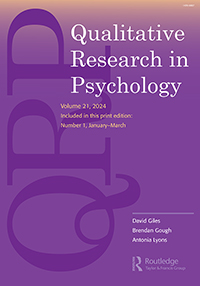观看他人观看的启示:在跨文化母婴研究中,使用视频小插曲和叙事访谈来获取多重立场和体现信息
IF 4.4
3区 心理学
Q1 PSYCHOLOGY, MULTIDISCIPLINARY
引用次数: 1
摘要
众所周知,文化嵌入和体现的相互作用的理解是难以获得的,这种理解是代际传播的,通常是通过感觉和情感记忆无意识地传播的。这些信息通常包含在内隐记忆中,不容易用于叙事解释。需要能够访问这些意义模型的替代方法。虽然母婴互动视频长期以来被用于评估和临床干预,但本文提出在观察互动视频时使用参与者评论作为定性研究方法,并与叙述性访谈一起使用。这种双重方法的效用通过其在一项旨在了解南非乡镇环境中当地对产妇敏感反应的理解的研究中的使用来证明。通过分析参与者对视频材料的回答以及他们对访谈问题的回答,本文表明,参与者对视频材料的反思与叙事访谈一起使用,可以分析和解释参与者身份和立场的变化,从而在理解文化嵌入的亲子互动中获得更大的复杂性。本文章由计算机程序翻译,如有差异,请以英文原文为准。
What watching others watching can tell us: using video vignettes alongside narrative interviews to access multiple positions and embodied information in cross-cultural mother-infant research
ABSTRACT Culturally-embedded and embodied understandings of interaction, transmitted intergenerationally, and often non-consciously through sensory and affective memory, are notoriously difficult to access. Such information is often contained in implicit memory and is not readily available for narrative explanation. Alternative methodologies that can access these models of meaning are required. While videos of mother-infant interaction have long been used for both assessment and clinical intervention, in this paper, the use of participant commentary during observation of interactional videos as a qualitative research method, alongside narrative interviews, is proposed. The utility of this dual method is demonstrated through its use in a study aimed at understanding local understandings of maternal sensitive responsiveness in a South African township setting. By analysing participant responses to video material alongside their answers to interview questions, this paper suggests that participant reflection on video material utilised alongside narrative interviewing allows for analysis and interpretation of shifting participant identifications and positions, capturing greater complexity in understandings of culturally-embedded parent-infant interaction.
求助全文
通过发布文献求助,成功后即可免费获取论文全文。
去求助
来源期刊

Qualitative Research in Psychology
PSYCHOLOGY, MULTIDISCIPLINARY-
CiteScore
20.00
自引率
0.50%
发文量
14
期刊介绍:
Qualitative Research in Psychology is an international, peer-reviewed journal that publishes high-quality, original research. It aims to become the primary forum for qualitative researchers in all areas of psychology, including cognitive, social, developmental, educational, clinical, health, and forensic psychology. The journal also welcomes psychologically relevant qualitative research from other disciplines. It seeks innovative and pioneering work that advances the field of qualitative research in psychology.
The journal has published state-of-the-art debates on various research approaches, methods, and analytic techniques, such as discourse analysis, interpretative phenomenological analysis, visual analyses, and online research. It has also explored the role of qualitative research in fields like psychosocial studies and feminist psychology. Additionally, the journal has provided informative articles on ethics, transcription, interviewee recruitment, and has introduced innovative research techniques like photovoice, autoethnography, template analysis, and psychogeography.
While the predominant audience consists of psychology professionals using qualitative research methods in academic, clinical, or occupational settings, the journal has an interdisciplinary focus. It aims to raise awareness of psychology as a social science that encompasses various qualitative approaches.
In summary, Qualitative Research in Psychology is a leading forum for qualitative researchers in psychology. It publishes cutting-edge research, explores different research approaches and techniques, and encourages interdisciplinary collaboration.
 求助内容:
求助内容: 应助结果提醒方式:
应助结果提醒方式:


